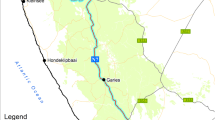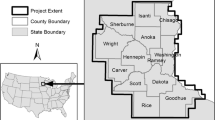Abstract
Carolina Bay wetlands are common in the southeastern US Coastal Plain and important to water quality, carbon sequestration, and habitat. Only South Carolina and Georgia have statewide inventories. We developed and evaluated a novel way to identify and delineate Bays using Bay-dense Bladen County, NC as a testbed. We posited that Bay land use had changed in the past 40 years and that Bays comprise a small subset of their surrounding soils. We classified decadal Landsat images as forest, agriculture, urban, and water. We used 812 previously delineated Bays to identify common Bay soils. From areas with common Bay soils and land-use change, we identified 548 new Bays and delineated them using a semi-automated on-line digitization tool. We saved new Bays to a Google Fusion Table for download and integration within a GIS. To gauge accuracy, Bays were scored on soils, land-use change, wetland delineation, and landscape position. Potential errors included omission of some small Bays (3.3–14.6 % of total Bay area) and commission of misclassified Bays (11 % of 1360 Bays), an estimated overall accuracy of 74 to 86 %. With 1360 delineated Bays, we estimated that as many as 478 have not yet been identified. These are most likely <5.76 ha.




Similar content being viewed by others
References
Aldous AR, Craft CB, Stevens JS, Barry MJ, Bach L (2007) Soil phosphorus release from a restoration wetland. Wetlands 27:1025–1035
Anderson MC, Allen RG, Morse A, Kustas WP (2012) Use of Landsat thermal imagery in monitoring evapotranspiration and managing water resources. Remote Sensing Environment 122:50–65
Bennet SH, Nelson JB (1991) Distribution and status of Carolina Bays in South Carolina. SC wildlife and Marine Resources Department, Columbia SC. Nongame and Trust Publication No. 1
Cintos Research (2016) Collaborative Survey of Carolina Bay Landforms. http://cintos.org/Survey/index.html. Accessed 25 Oct 2016
Dorney J, Huggett D, Ferrell R (2004) North Carolina Wetlands http://www.aswm.org/swp/north_carolina.pdf. Accessed 4 May 2016
Dvorett D, Davis C, Papeş M (2016) Mapping and hydrologic attribution of temporary wetlands using recurrent Landsat imagery. Wetlands. doi:10.1007/s13157-016-0752-9
Ewing JM, Vepraskas MJ, Broome SW, White JG (2012) Changes in wetland soil morphological and chemical properties after 15, 20, and 30 years of agricultural production. Geoderma 179–180:73–80
Fenstermacher DE, Rabenhorst MC, Lang MW, McCarty GW, Needelman BA (2014) Distribution, morphometry, and land use of Delmarva bays. Wetlands 34:1219–1228
NC Floodplain Mapping Program (2016) Flood risk information system http://www.ncfloodmaps.com/. Accessed 4 May 2016
Frost CC (1993) Four centuries of changing landscape patterns in the longleaf pine ecosystem. In: Proc. Tall timbers fire ecology conference, No. 1. The longleaf pine ecosystem: ecology, restoration and management. Tall timbers research station, Tallahassee, FL
Huang X, Senthilkumar S, Kravchenko A, Thelen K, Qi J (2007) Total carbon mapping in glacial till soils using near-infrared spectroscopy, Landsat imagery and topographical information. Geoderma 141:34–42
Huang C, Peng Y, Lang M, Yeo I, McCarty G (2014) Wetland inundation mapping and change monitoring using Landsat and airborne LiDAR data. Remote Sensing Environment 141:231–242
Knight RL, Bays JS, Richards FR (1980) Floral composition, soil relations and hydrology of a Carolina Bay in South Carolina. In: Sharitz RR, Gibbons JW (eds) Freshwater Wetlands and Wildlife. USDOE, Office of Scientific and Technical Information. Oak Ridge, TN USA. CONF-8603101
Lide RF, Meentemeyer BG, Pinder JE, Beatty M (1995) Hydrology of a Carolina Bay located on the upper coastal plain of western South Carolina. Wetlands 15:47–57
McKerrow AJ, Williams SG, Collazo JA (2006) The North Carolina gap analysis project: final report. NC cooperative fish and wildlife research unit, NC State University, Raleigh, NC
Melton FA, Schriever W (1933) The Carolina bays- are they meteorite scars? Journal of Geology 41:52–66
Munoz B, Lesser V, Dorney J, Savage R (2009) A proposed methodology to determine the accuracy of location and extent of geographically isolated wetlands. Environmental Monitoring Assessment 150:53–64
NASA (2016) Landsat Science http://landsat.gsfc.nasa.gov/. Accessed 4 May 2016
Newman MC, Schalles JF (1990) The water chemistry of Carolina bays: a regional study. Archiv für Hydrobiologie 118:147–168
Prouty WF (1952) Carolina bays and their origin. Geol Soc Am Bull 63(2):167
Savage H (1982) The mysterious Carolina bays. University of South Carolina Press, Columbia
Sharitz RR (2003) Carolina Bay wetlands: unique habitats of the southeastern United States. Wetlands 23:550–562
Singh D (2011) Generation and evaluation of gross primary productivity using Landsat data through blending with MODIS data. International Journal Applied Earth Observation and Geoinformation 13:59–69
Soil Survey Staff (2014) Soil survey geographic database (SSURGO). Natural Resources Conservation Service, United States Department of Agriculture. http://websoilsurvey.nrcs.usda.gov. Accessed 4 May 2016
USDA-FSA Aerial Photography Field Office (2010) ortho_1-1_1n_s_nc155_2010_1 and ortho_1-1_1n_s_nc017_2010_1. http://gdg.sc.egov.usda.gov. Accessed 25 Oct 2016
USDA-NRCS (2016) Geospatial Data Gateway https://gdg.sc.egov.usda.gov/. Accessed 4 May 2016
USEPA (2015) Memorandum of Agreement Between the Department of the Army and the Environmental Protection Agency: The Determination of Mitigation Under the Clean Water Act Section 404(b)(1) Guidelines https://www.epa.gov/cwa-404/memorandum-agreement. Accessed 4 May 2016
USEPA (2016) Section 404 of the Clean Water Act https://www.epa.gov/cwa-404/memorandum-agreement. Accessed 4 May 2016
USFWS (2003) 504 FW 4 Wetland Conservation – Swampbuster http://www.fws.gov/policy/504fw4.html. Accessed 4 May 2016
USFWS (2016) Wetland Mapper http://www.fws.gov/wetlands/Data/Mapper.html. Accessed 4 May 2016
USGS (2015) The National Map http://nationalmap.gov/elevation.html. Accessed 4 May 2016
Acknowledgments
We thank Michael Davias of Cintos Research for assistance with their Collaborative Survey of Carolina Bay Landforms. Our research was funded in part by a grant from the USDA National Institute of Food and Agriculture.
Author information
Authors and Affiliations
Corresponding author
Rights and permissions
About this article
Cite this article
Sullivan, D.G., White, J.G. & Vepraskas, M.J. Using Land-Use Change, Soil Characteristics, and a Semi-Automated On-Line GIS Database to Inventory Carolina Bays. Wetlands 37, 89–98 (2017). https://doi.org/10.1007/s13157-016-0842-8
Received:
Accepted:
Published:
Issue Date:
DOI: https://doi.org/10.1007/s13157-016-0842-8




